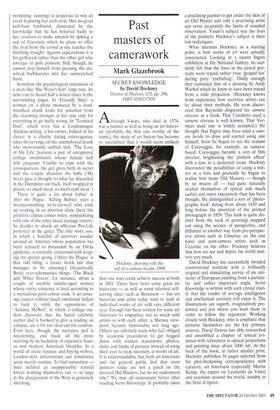Past masters of camerawork
Mark Glazebrook
SECRET KNOWLEDGE by David Hockney Thames & Hudson, .E35, pp. 296, ISBN 0500237858 Although Vasari, who died in 1574, was a painter as well as being an art historian (probably the first one worthy of the name), the study of art history has become so specialised that it would seem unlikely that one man could achieve success at both in 2001. There have been some great art historians ŌĆö as well as some talented selfserving fakes such as Berenson ŌĆö but art historian and artist today tend to look at individual works of art with very different eyes. Enough has been written for some art historians to empathise not so much with artists as with each other: a Marxist viewpoint became fashionable not long ago. Others are scholarly souls who feel obliged by academic procedures to get bogged down with written documents, photos, slides and backs of pictures instead of using their eyes to look intensely at works of art. It is understandable that both art historians and the general public feel that most painters today are not a patch on the revered Old Masters, but do we understand why? We may all understand better after reading Secret Knowledge. It probably takes
a practising painter to get under the skin of an Old Master and only a practising artist can sense accurately the limits of unaided observation. Vasari's subject was the lives of the painters; Hockney's subject is their lost techniques.
What interests Hackney, as a starting point, is how works of art were actually constructed. Looking at a recent Ingres exhibition at the National Gallery, he suddenly felt that the lines in the pencil portraits were traced rather than 'groped for' during pure 'eyeballing'. Oddly enough they reminded him of a drawing by Andy Warhol which he knew to have been traced from a slide projection. (Hackney knows from experience how secretive artists can be about their methods. He soon discovered that Reynolds disguised his camera obscura as a book. That Canaletto used a camera obscura is well known. That Vermeer used one is widely accepted.) He thought that Ingres may have used a camera lucida to draw and started using one himself. Soon he began to see the realism of Caravaggio, for example, as camerabased. Caravaggio became a sort of film director, brightening the 'pinhole effect' with a lens in a darkened room. Hockney discovered the possibilities of using a mirror as a lens and gradually he began to realise how many Old Masters ŌĆö though by no means all ŌĆö had quite naturally availed themselves of optical aids much earlier and more extensively than has been thought. He distinguished a sort of 'photographic look' dating from about 1430 and long before the invention of the printed photograph in 1839. This look is quite distinct from the look of paintings mapped out using the science of perspective, and different in another way from pre-perspective artists such as Cimabue on the one hand and post-camera artists such as Cezanne on the other. Hockney believes that how we see and depict the world matters very much.
David Hockney has successfully invaded controversial territory with a brilliantly original and stimulating survey of six centuries of European painting from a particular and rather important angle. Secret Knowledge is written with such crystal clarity that the reader of average intelligence and intellectual curiosity will enjoy it. The illustrations are superb, imaginatively presented and just where you want them in order to follow the argument. Working closely with Hackney, who is emphatic that pictures themselves are the key primary sources, David Graves has ably researched and assembled a chapter of textual evidence with references to optical projections and painting since about 1000 AD. At the back of the book, in rather smaller print, Hockney publishes 56 pages selected from his plot-thickening correspondence with curators, art historians (especially Martin Kemp, the expert on Leonardo da Vinci) and scientists around the world, notably in the field of optics.


























































































 Previous page
Previous page